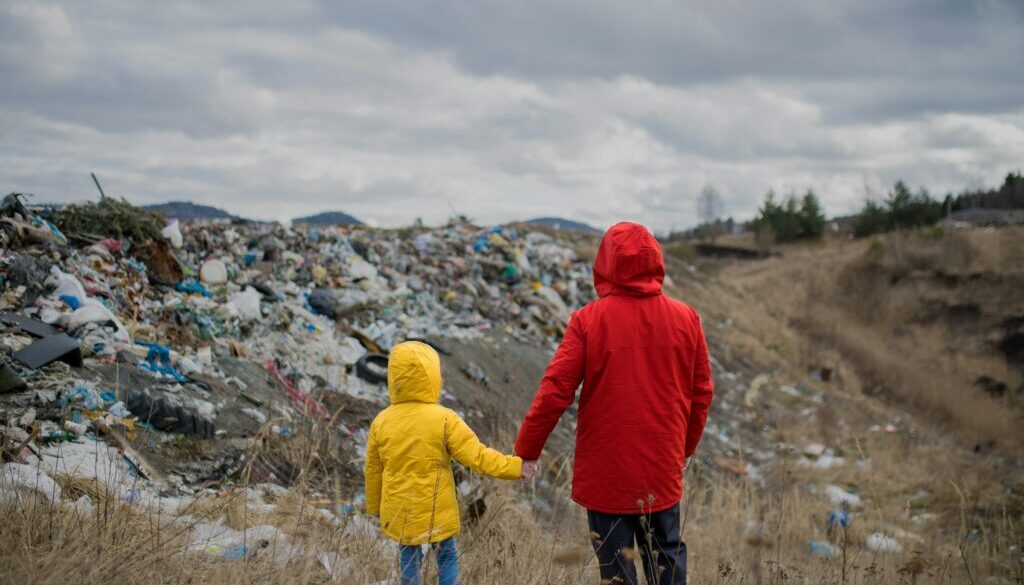US landfills emit nearly a ton of airborne PFAS a year, study finds
Listen to the audio version of this article (generated by AI).
US municipal landfills leak roughly 1,800 pounds of PFAS into the air annually — evidence that the country’s garbage dumps are a persistent source of airborne “forever chemicals,” according to a new nationwide study.
Researchers from North Carolina State University (NCSU) and Oregon State University (OSU) measured levels of per- and polyfluoroalkyl substances (PFAS) in gases emitted from 30 municipal landfills of varying ages across the US. Most of the PFAS found were a specific type called fluorotelomer alcohols (FTOHs), which are produced when common PFAS-based water repellent coatings on household items, including stain-resistant carpet and couches or waterproof rain jackets and boots, slowly break down.
While more research is needed to establish the potential health risks from exposure to airborne PFAS from landfills, the study, published this month in Environmental Science & Technology, shows that landfills could be a long-term source of PFAS emissions to the environment and points to the need for more accurate accounting of their fate and transport after disposal, said Courtney Carignan, an epidemiologist at Michigan State University who was not involved in the study.
As microorganisms digest organic matter such as paper or food in landfills, they generate gas, much of which is methane, a potent greenhouse gas. Within five years of operation, per US Environmental Protection Agency (EPA) regulations, landfills must collect the gas that is produced and treat it before emission. Landfill gas is usually burned for energy or flared off. However, an estimated half of landfill gas generated is collected while the rest escapes into the atmosphere, carrying with it other pollutants including PFAS, according to models built from EPA data.
The study emphasizes “the importance of collecting landfill gas, which is already important because it’s 50% methane,” said Morton Barlaz, an environmental engineer at NCSU and senior author of the study.
PFAS emissions were detected at all 30 landfills, including three that were more than 60 years old, and three that are closed. After measuring the PFAS concentrations in landfill gas, the researchers then combined their data with available EPA data on uncollected landfill gas to model how much PFAS could be emitted along with uncollected landfill gas coming from municipal landfills across the US.
“We would expect really long-term release of PFAS,” said Florentino De la Cruz, an environmental engineer now at the University of North Florida, who conducted the study while at Barlaz’s group at NCSU.
“We would expect really long-term release of PFAS.” – Florentino De la Cruz, University of North Florida
Previous research found that landfills can contribute PFAS to the environment through leachate — a liquid that is produced as rain seeps through the landfill. With modern lined landfills, this leachate is typically pumped out and treated at wastewater treatment plants. However, most municipal wastewater treatment plants aren’t equipped to remove PFAS, so the chemicals often end up being discharged into rivers along with the treated wastewater or contaminate nutrient-rich biosolids sometimes spread on agricultural fields. In 2017, the NCSU and OSU research teams found that landfill leachate may contribute about 1,300 lbs of PFAS into the environment through these pathways every year.
De la Cruz is now working with collaborators at the University of North Florida to figure out how well PFAS are destroyed, or how they could transform into other chemicals, when landfill gas is burned off. The current estimates assume that the flaring process destroys all the PFAS, so the modeled emissions from landfill gas could be higher if it turns out that the chemicals can survive flaring. Landfills could also leak PFAS during the first five years of operation when they are not required to collect gas.
Workers and communities at risk
The new study raises concerns about the potential exposure of landfill workers or communities that live near landfills, especially downwind, to airborne FTOHs. FTOHs can transform in the environment or even within the human body into other PFAS chemicals with well-established negative health effects, including perfluorooctanoic acid (PFOA), which is linked to two types of cancer and compromised immune function.
“A quick calculation indicates potential risk from breathing air containing FTOH at the reported levels for more than an hour per day over a year or more,” Carignan said. “However, more information is needed as most people wouldn’t put their face to a landfill vent for very long and levels in air should be much lower even a few feet away.”
De la Cruz and his collaborators are also working to model how PFAS moves through the atmosphere to figure out how far the airborne chemicals can travel and how much they get diluted.
Phasing out unnecessary uses of PFAS chemicals in consumer products would be more helpful in reducing exposure, especially in the long run, researchers said.
“Landfills do not make PFAS,” Barlaz said. “People buy things that have PFAS on them and then they dispose of them, and so in terms of getting rid of PFAS, it’s really about stopping using it in manufacturing.”
But Barlaz and De la Cruz also say that the chemicals may be required for certain applications and that completely eliminating PFAS from all products is impractical. Meanwhile, there are still a lot of PFAS-treated consumer products already in landfills, on the marketplace and in people’s homes — which means, for now, stemming landfill emissions is key to addressing the problem.
“Some of it is managing the gas and some of it is deciding what’s OK in consumer products,” Barlaz said.
Featured image: Unsplash +/Getty Images



